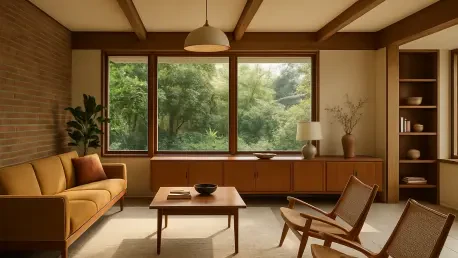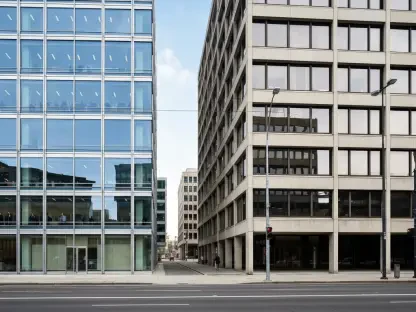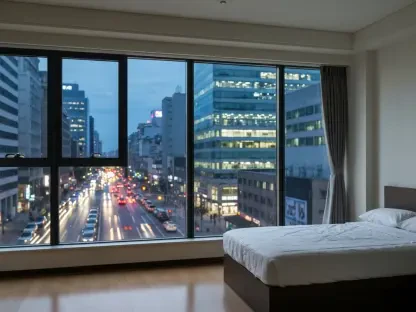In the heart of northern Atlanta, a remarkable transformation has turned a 7,000-square-foot contemporary home, originally built in 2010, into a vibrant family sanctuary brimming with character. This modern spec house, initially devoid of the inherent charm found in historic properties, became a canvas for creativity when a couple with two young children sought the expertise of local designer Laura W. Jenkins. Hired after being discovered through social media, Jenkins embraced the challenge of infusing the space with personality, ensuring it reflected the family’s unique tastes and dynamics. The result is a stunning residence that elegantly combines vintage treasures with modern aesthetics, demonstrating that even the most standardized structures can become deeply personal through intentional design. This project not only redefined the home’s identity but also highlighted the power of thoughtful curation in creating spaces that resonate with their inhabitants on every level.
Crafting a Personal Narrative Through Design
The foundation of this Atlanta home’s redesign rests on a profound dedication to personalization, ensuring every detail mirrors the family’s story. The journey began with a poignant artifact—a cream-colored secretary adorned with red and blue neoclassical motifs, a relic from the wife’s childhood bedroom. This piece became the linchpin for the home’s color scheme, inspiring a harmonious blend of neutral tones and vibrant pops of color across various rooms. Jenkins meticulously wove this personal element into the broader design, transforming a generic modern space into a haven that speaks to the family’s history and values. The approach underscores how meaningful objects can anchor a home’s aesthetic, turning impersonal architecture into a narrative-rich environment that feels uniquely tailored to its occupants, setting the tone for every subsequent design decision.
Beyond the initial inspiration, personalization extended to crafting spaces that resonate with the family’s lifestyle and emotional needs. Each room was thoughtfully designed to evoke a sense of belonging, from the choice of textures to the placement of cherished items. Jenkins focused on creating an atmosphere where memories could be made, ensuring the home was not just visually appealing but also deeply comforting. This meant balancing the elegance of curated pieces with the practicality required for daily life, allowing the family to live fully within a space that feels like an extension of their identity. The emphasis on individual expression turned the house into a storytelling vessel, where every corner holds significance, reflecting a commitment to design that prioritizes personal connection over mere aesthetics.
Bridging Time Periods for Visual Harmony
One of the most striking aspects of this renovation is the deliberate fusion of vintage and modern elements, creating a dynamic interplay Jenkins refers to as “style tension.” In the dining room, for instance, vintage chairs reupholstered in fresh, contemporary fabrics are paired with a midcentury sideboard by Paolo Buffa, while a custom rug draws inspiration from a 1930s geometric pattern. This thoughtful mixing of eras ensures that each space feels layered and intriguing, avoiding the monotony often associated with modern spec homes. The result is an environment that pays homage to the past while embracing the present, offering a visual dialogue between different design periods that captivates and inspires, making the home a testament to timeless creativity.
This blending of styles extends throughout the residence, with the primary suite featuring antique furnishings alongside sleek modern fixtures for a balanced aesthetic. The careful curation of pieces from various time periods prevents any single era from dominating, instead fostering a cohesive look that feels both nostalgic and innovative. Jenkins’ approach highlights a growing trend in design where history and modernity are not at odds but rather complementary forces that enrich a space. By integrating these contrasting elements, the home achieves a sense of depth and character, proving that design can transcend temporal boundaries to create environments that are as engaging as they are enduring, appealing to a wide range of sensibilities.
Color as a Tool for Emotional Impact
Color serves as a powerful instrument in shaping the mood and personality of this Atlanta residence, with Jenkins employing a strategic palette to evoke specific emotions. Anchored by neutral foundations, the home comes alive through bold statements like the dining room’s deep crimson walls, painted in Farrow & Ball’s Rectory Red, which craft a dramatic yet welcoming ambiance. Similarly, the keeping room’s inky blue hue and the kitchen’s sage-and-cream tones, accented by Breakfast Room Green cabinets, infuse warmth and individuality into everyday spaces. This intentional use of color transforms the house into a series of emotional experiences, balancing striking visuals with a sense of comfort that makes each room uniquely inviting.
The thoughtful application of color also serves to delineate spaces within the sprawling layout, guiding the eye and defining purpose without overpowering the overall harmony. In areas meant for relaxation, softer tones create a calming retreat, while vibrant shades in communal zones energize and inspire connection. Jenkins’ mastery lies in knowing when to push boundaries with daring hues and when to pull back with subtle elegance, ensuring the palette enhances rather than competes with the home’s eclectic furnishings. This nuanced approach to color not only elevates the aesthetic appeal but also underscores how design can influence daily life, shaping the way inhabitants feel and interact within their environment on a profound level.
Balancing Elegance with Everyday Practicality
Despite its polished and sophisticated appearance, this home remains steadfastly functional for a family with young children, proving that beauty and practicality can coexist. The upstairs playroom exemplifies this balance, incorporating durable materials like Missoni for Stark rugs alongside kid-friendly pieces such as red Roly Poly chairs by Faye Toogood and a plush RH sectional. These choices ensure the space withstands the rigors of active play while maintaining a stylish edge. By prioritizing resilience without sacrificing design integrity, the home becomes a place where children can explore and grow, surrounded by an environment that inspires creativity while offering the necessary durability for family life.
Further emphasizing this duality, the children’s bedrooms blend bespoke elements with vintage charm, creating spaces that feel mature yet approachable. Features like a tented bed for the daughter add whimsy, while carefully selected antique finds lend a sense of history, ensuring the rooms grow with their young occupants. Jenkins’ design philosophy here reflects a broader understanding of family dynamics, crafting areas that cater to both the aesthetic aspirations of adults and the practical needs of children. This harmonious integration ensures the home serves as a nurturing backdrop for all its residents, offering a seamless blend of elegance and livability that adapts to the demands of daily routines while preserving a refined atmosphere.
Reflecting on a Design Triumph
Looking back, the renovation of this northern Atlanta home stands as a powerful example of how personalized design can transform a generic structure into a cherished family haven. Laura W. Jenkins masterfully navigated the challenges of a modern spec house, using a childhood heirloom as the catalyst for a narrative that wove together bold colors, vintage pieces, and contemporary touches. The striking crimson dining room, the calming yet vibrant kitchen, and the durable yet stylish playroom all spoke to a vision that balanced aesthetics with functionality. This project not only reshaped a 7,000-square-foot space but also set a benchmark for how design can reflect individuality. Moving forward, such transformations encourage homeowners to consider how their spaces can tell their stories, suggesting that collaboration with visionary designers can unlock the full potential of any home, no matter its starting point.









